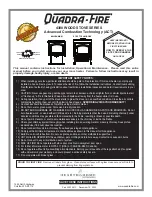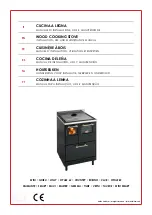
12
2-INSTALLATION
FOREWORD
The heating system (gen combustion air combustion product expulsion any hydraulic/aeraulic
system) must be installed in compliance with the laws and regulations in force
1
, and carried out by a qualified technician,
who must issue a declaration of conformity of the system to the system manager and shall undertake full responsibility
for final installation and consequent good operation of the product.
The manufacturer declines all responsibility in the event of installations that do not comply with the laws and regulations in force and
inappropriate use of the appliance.
In particular one must ensure that:
•
the environment is suitable for installing the appliance (floor load-bearing capacity, presence or possibility of creating an adequate
electrical/hydrauic/aeraulic system when required, volume compatible with the appliance characteristics, etc.);
•
the appliance is connected to a smoke expulsion system correctly sized according to EN 13384-1, which is resistant to soot fire and
which complies with the distances prescribed by the combustible materials indicated on the plate data;
•
there is a suitable combustion air flow to the appliance;
•
other combustion appliances or extraction devices installed do not cause a negative pressure of more than 4 Pa in the room where
the product is installed compared to the outside (only sealed appliances are allowed a maximum of 15 Pa of negative pressure in
the room).
1
The national reference standard for the installation of domestic appliances is UNI 10683 (IT) - DTU NF 24.1 (FR) - DIN 18896 (DE) - NBN B 61-002 (BE) - Real Decreto 1027/2007
(ES)
In particular, it is recommended to strictly observe the safety distances from combustible materials to avoid serious harm
to people and to the integrity of the home.
Installation of the appliance must ensure easy access to service the appliance itself, the smoke channels and the flue.
Always maintain adequate distance and protection in order to prevent the product from coming into contact with water.
It is forbidden to install the stove in rooms with a fire hazard.
With the exception of sealed installations, it is also forbidden for liquid fuel appliances with continuous or intermittent
operation that draw the combustion air from the room they are installed in or B-type gas heating appliances, with or
without the production of domestic hot water, to coexist in the same room or in interconnecting rooms.
Sealed installation means that the product is certified as sealed and its installation (ducting of the combustion air
and connection to the chimney) is airtight with respect to the installation environment.
A sealed installation does not consume the room’s oxygen but draws all the air from the outer environment (if suitably ducted) and makes
it possible to install the product, therefore, it can be installed in all houses that require a high degree of insulation such as “passive” or
“high energy efficiency” houses. Thanks to this technology there is no risk of smoke emissions in the room, hence no air inlets and relevant
ventilation grilles are required in the installation premises.
Consequently, there will be no more draughts of cold air in the room, which would otherwise make it less comfortable and reduce the
overall efficiency of the system. The sealed stove may even be installed in a sealed installation that is compatible with the presence of
forced ventilation or in premises that might have negative pressure with respect to the outside.















































